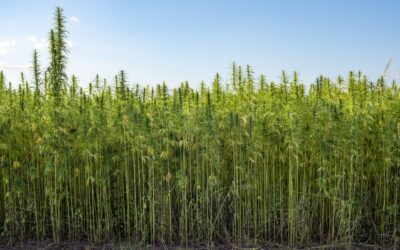Not many people realise that hemp has been around and used for various purposes since ancient times. Today, hemp is seen as a plant that provides CBD and other products. However, the history of hemp is quite fascinating!
Hemp Was Known & Used in Ancient Times
Hemp is one of mankind’s oldest and most versatile cultivated plants. The plant has been economically significant for more than 6,000 years. The first mention of hemp was in China, back in 2800 BC. The Chinese used the plant to create the world’s first rope. The rope was made of twisted hemp fibres; however, the Chinese also used hemp to make paper.
By the 28th century BC, China began to make clothing from hemp fibres. Some of the oldest preserved textiles date back to about 1000 BC.
By the 17th century, hemp became extremely popular in Europe, where the fibres were used to create sails, ropes, nets, and even flags for sailing ships. Hemp was used for these purposes because it proved to be strong and resistant to tearing, even when wet. The fibres were also used to make the sailors’ uniforms. Consider the fact that one ship required between 50 to 100 tonnes of hemp fibre every other year.
By the 18th century, the use of hemp began to fall in favour of flax, nettle, and wool. These materials overcame the use of hemp in the European textile industry. Also, at this time, pulp (made from rags) was used to produce paper.
The decline of the hemp industry in Europe continued into the 20th century. By then, hemp use was minimal, at best. It was only recently that interest in the plant began to grow. This can be put down to hemp’s many ingredients.
Hemp Use During WWII
Another interesting fact from hemp’s long history is that the plant was used during WWII. At this time, hemp’s use was prohibited; however, about the same time, the synthetic fibre industry began to have problems. This relatively new industry ran out of fibre to create uniforms for the armed forces. Then, in 1942, the US decided to put hemp back to use.
The US government produced and distributed a movie called “Hemp for Victory,” where they promoted the uses of hemp and provided detailed information on the cultivation and harvesting of the plant. In the movie, the message sent to the public was that hemp could be used for mooring ships, tackle & gear, shoes, and even parachute webbing!
At the end of the war, hemp fell into disuse once again. Synthetic fibres were taking over with more efficient production. The military even had their soldiers use flame-throwers and crop dusters to destroy millions of acres of hemp (the plants had been planted to support war efforts). So you could say this was when the modern war against marijuana and hemp began.
Hemp Used as Food
Hemp has also been used as a food product! The plant’s seeds are drug-free and very nutritious. The seeds can be eaten whole, used to produce edible oil, and even ground to make flour. Hemp seeds are also one of the best sources of vegetable protein. In addition, they contain essential amino acids, essential fatty acids, and more. The seeds are also said to help lower blood cholesterol and dissolve plaque in arteries.
Hemp is very easy to grow and has the ability to grow where other food plants aren’t able to grow. It’s even possible to grow hemp plants in dry regions, such as deserts or areas with short growing seasons (such as in Scandinavia).
Hemp Can Be Used as Fuel
Another interesting fact about hemp history is that the plant can be used as fuel! The seeds of the plant can be used as combustible fuel oil. In addition, they can be made into ethanol, which is one of the cleanest-burning liquid fuel alternatives to gasoline.
In a test between unleaded gasoline and hemp fuel, a car engine produced black carbon residue exhaust. However, when hemp seed fuel was used, the engine produced residue-free exhaust. What’s more, the ethanol made from hemp releases water vapour and carbon dioxide. The carbon dioxide is breathed in by plants to create water, making ethanol from hemp a sustainable, clean fuel.
Concrete Made from Hemp
Hemp has also been used to create hemp concrete in France. The “recipe” was based on ancient Egyptian hemp-based concrete. The inner fibre of the plant (called hemp hurds) is mixed with limestone and water, which works to harden the mix into a material that’s harder and lighter than cement.
What’s more, hemp concrete is also more flexible than regular concrete, which is an excellent advantage for buildings located in earth-quake-prone areas worldwide.
Hemp is a Great Rotation Crop & Soil Renewer
Farmers around the world also favour hemp for being an excellent rotation crop, which also renews the soil. The plants put down a root about 12 inches long in about 30 days. The plants also work to prevent soil erosion. What’s more, the plant has low water requirements, which means farmers don’t have to irrigate their hemp crops as much. The plants even grow in arid areas.
In addition, hemp plants tend to mature in only three months. The benefit here is that with a shorter growing season, farmers can use the soil for additional crops. Hemp plants take nutrients from the soil and concentrate these in the plant’s leaves and roots. Once the harvest is complete, the roots remain, and the leaves are returned to the soil, rejuvenating the soil in the process.
The plants also keep weeds at bay, which means farmers don’t have to use herbicides on the crops. And because the plants utilise nutrients from the soil, there’s no need to use fertilisers. Hemp crops are also naturally pest-free. As a result, they don’t require the use of pesticides.
Overall, hemp leaves the soil in much better condition than before the crop was planted! The fields used to grow hemp can then be used to grow other crops in rotation.
Summing It Up
As you can see, hemp has a very interesting history and many uses beyond CBD products. What’s more, hemp plants are a sustainable source of many products. It’s able to grow in many parts of the world and even helps the Earth!
Hemp’s a valuable, sustainable product for us and the planet.

 Call WhatsApp +1-831-884-3124
Call WhatsApp +1-831-884-3124
 info@californiagrownhemp.ch
info@californiagrownhemp.ch


